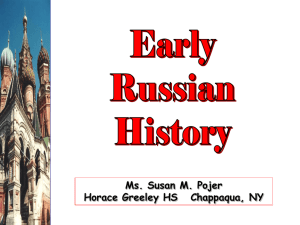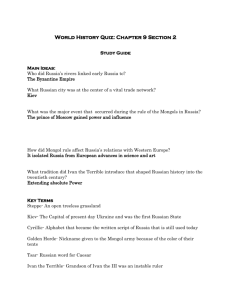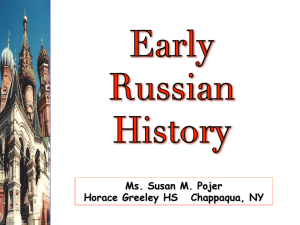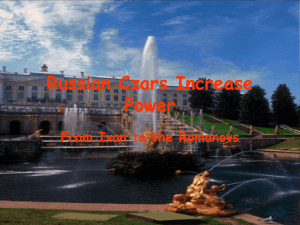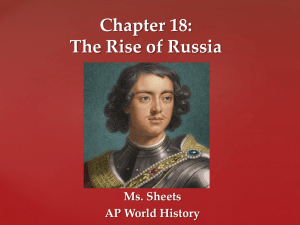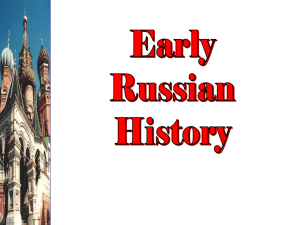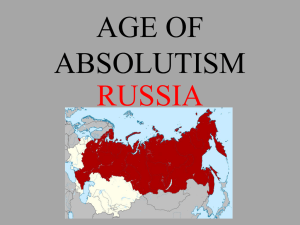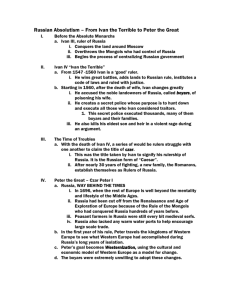Chapter 18: The Rise of Russia - Ms. Sheets' AP World History Class
advertisement
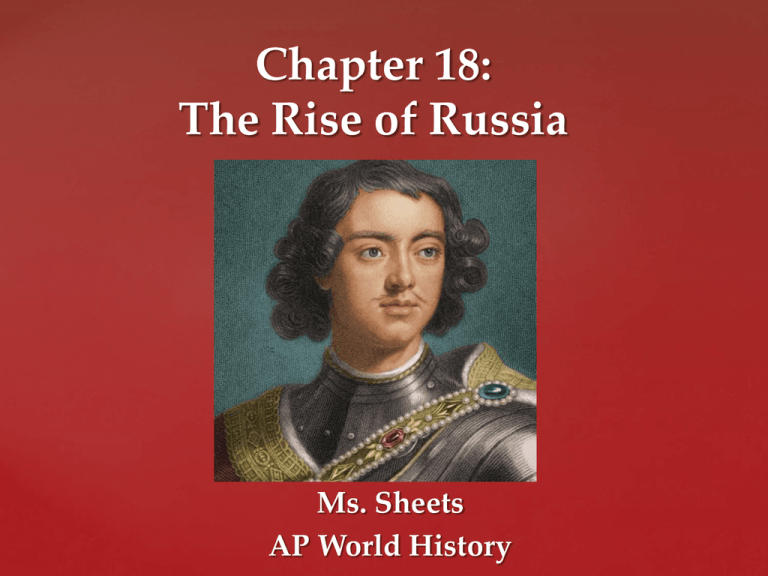
Chapter 18: The Rise of Russia Ms. Sheets AP World History A Newly Independent Russia 1380: Battle of Kulikova (alliance of Russian feudal princes) led to Golden Horde defeat Mongol attempts to subjugate Russians continued for nearly 100 years By 1480: Russia had fully gained independence and had pushed the Mongols out of Russian lands Led by Duchy of Moscow and Ivan III Ivan III refused to pay Mongol tribute Mongols left Russia weak and isolated in connections, especially with Western Europe. Mongols reduced vitality of Russian culture. Economic life was slow. Trade was low; limited manufacturing Purely an agricultural economy reliant on peasant labor Ivan III Emergence as a New Power Ivan III (Ivan the Great) (reign 1462-1505) Makes Russian rule legitimate Organized a strong military to push Mongols back Gained territory for Moscow Asserted control over all Orthodox churches Ivan IV (Ivan the Terrible) (reign 1547–1584) Continued territorial expansion into Siberia Killed supposed opposition through the Oprichniki (police group) Established absolute monarchy while weakening authority of boyars Confiscated boyar estates and redistributed land to supporters Dies without an heir Expansion Under the Ivans Territorial expansion pushed Mongols back. Ivan IV recruited Cossacks (Russian peasant pioneers/military) to aid expansion. Took over sparsely populated regions Expansion leads to addition of Muslims in Central Asia to Russian territory Expansion offered rewards; Tsars gave nobles and bureaucrats estates on new land. Tsars had contacts with Western Europe. Ivan III: diplomatic missions Ivan IV: established trading contacts (traded fur and raw materials for manufactured products) Russian Expansion Under the Early Tsars From its base in the Moscow region, Russia expanded in three directions (N; W; S); the move into Siberia under Ivan the Terrible involved pioneering new settlements, as the government encouraged Russians to push eastward. Quick Review Question What is an accomplishment of Ivan III? What is an accomplishment of Ivan IV? Who are the Cossacks and how did they affect Russian history? Romanov Dynasty Time of Troubles Ivan IV died without an heir. Period of rebellion, civil war New claims to power by boyars Weakness leads to attacks from Sweden and Poland. Romanov Dynasty (1613-1917 CE) Mikhail Romanov (1st Romanov) reestablished internal order. Drove out invaders. Expanded borders up to Ottoman Empire Alexis Romanov (2nd Romanov) Put state in control of Russian Orthodox Church. Peter the Great Peter I (Peter the Great) (reign 1689-1725) Built up tsarist control over bureaucracy and military; absolute monarch Chancery of Secret Police Wanted to move Russia into Western sphere, but didn’t want Russia to become entirely Western Shifted focus of expansion westward: Attacked Sweden in the Great Northern War; secured an ice-free port (warmwater port) on Baltic Sea and created a navy Moved capital from Moscow to the new St. Petersburg Peter the Great’s Westernization: Political and Economic Improvements in political organization Specialization of Russian bureaucracy Revision of law codes Revised tax system (lower peasant taxes) Military improvements Improved weaponry (Western technology; cannons and firearms) Built a navy to defend ice-free port along Baltic Enlarged army (drafter soldiers; increased pay) Select officials according to merit, rather than aristocratic status Focus efforts on tax collection, and industrial production) Economic developments (inherited a Russia that was largely agricultural) Built up mining industries so Russia will not need to import metal for weapons Used Western technology knowledge Landlords rewarded for using a serf system Peter the Great’s Westernization: Social and Cultural Social reforms Brought Western European gender attitudes to Russia Changes to marriage ceremony: whip Russians may make their own choices regarding marriage partners Cultural change from his trips to Western European countries Brought Western science, technology, ballet Encouraged Western-styled clothing among boyars Remove beards from men, veils from women These changers were generally limited to the elite; no widespread cultural change occurred Russia Under Peter the Great From 1696 to 1725, Peter the Great allowed his country only one year of peace. For the rest of this reign he pursued war. By the end, he had established territory on the southern shores of the Baltic Sea, where he founded the new city of St. Petersburg. Quick Review Question What was the Great Northern War? What does it accomplish? What was included in Peter the Great’s Westernization program? Catherine the Great Peter the Great died in 1724 Several decades of weak rule Peter III took the throne in 1761; he was assassinated and his wife Catherine II rules Catherine II (Catherine the Great) (reigned 1762-1796) Defender of monarchical powers; strict interpretation of absolute monarchy Continues expansionist trends and westernization of Peter the Great Interested in Enlightenment The Catherinian Era Supported boyars: gave them new powers over serfs and their estates in exchange for their support of her Pugachev Rebellion (1773-1775) Claims she needs greater military and judicial powers Instruction of 1767 Selective Westernization Based on French Enlightenment Absolutism upheld, but equality of men before law Patronized Western-style art and architecture By 1798, Russia had the largest land empire in the world and is one of the great powers of Europe. Russian America Catherine the Great continued Russian expansion into Siberia; Alaska; N California Used for the Russian fur trade Russian population was 700 1860s: Overhunting had reduced available furs; distance from Russia made it difficult to supply Sold in 1867 to the U.S. for $7.2 million (2 cents an acre) Quick Review Question What was the Instruction of 1767? How does Catherine the Great use the Pugachev Rebellion to her advantage? Russian Serfdom 17th and 18th: serfs’ rights decreased. 1649: serfdom becomes hereditary By 1800, ½ people in Russia were serfs. Produce food for Russian masses; landlords sell food for a profit which they kept and did not distribute to serfs Struggling Russian economy leads peasants to fall into debt and accept serf status. Russia becomes subordinate to western economy Power of nobles over serfs steadily increased Way for government to satisfy the nobility and regulate peasants Serfs paid high taxes, were illiterate and poor Recurring serf rebellions and no social mobility Economics in Russia 95% of Russia was rural. 50% of population are serfs Russian economy produced enough money to support an expanding state and empire. Agricultural methods were highly traditional and limited (old technology) Serfs were unmotivated because extra production was taken by landlords Few artisans existed who produced goods, so there was no merchant class Most merchants are Westerners stationed in Russia Government has greater role in economy than West because of lack of merchants
